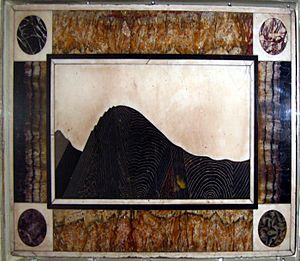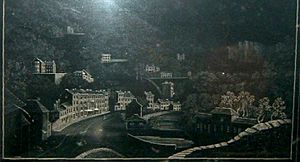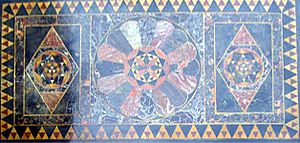Ashford Black Marble facts for kids
Ashford Black Marble is a special kind of dark rock found in Derbyshire, England. It comes from a place called Ashford-in-the-Water. When this rock is cut, shaped, and polished, it becomes super shiny and black. It looks a lot like marble, but it's actually a type of limestone. Geologists call it a sedimentary rock. This means it formed over millions of years from tiny bits of minerals and dust.
People use Ashford Black Marble to create beautiful art. They can cut it into shapes and combine it with other colorful stones. For example, the Derby Museum has a cool map of Ecton Hill made from this black marble and other minerals.
Contents
A Look Back in Time: History of Ashford Black Marble
Ashford Black Marble has been used for decorations for a very long time. Even in prehistoric times, people found ways to use this unique stone. Later, famous people like Bess of Hardwick were known to have items made from it.
How the Industry Grew
In the 1750s, a man named Henry Watson helped the local industry grow. He was important for making Ashford Black Marble popular for inlay work. Inlaying means putting different colored stones into the black marble to create pictures or patterns. Henry Watson had a special mill in Ashford-in-the-Water that used water power to work the stone.
During the late 1700s and early 1800s, many items made from Ashford Black Marble were sold. These included pots, tall pointed statues called obelisks, and other fancy decorations. John Mawe even had a museum in Matlock Bath where he sold black marble items. A talented artist named Ann Rayner used diamonds to carve detailed pictures into the black marble.
Today, you can see many beautiful Ashford Black Marble objects in museums. Places like the Derby Museum, Buxton Museum, and Chatsworth House have collections. In 2009, some very large pieces of Ashford Black Marble were found underground in Derby. These big rocks were very valuable. They might have been left behind when a marble factory moved in the 1880s.
What is Ashford Black Marble Made Of?
Ashford Black Marble is a type of limestone. It contains a lot of carbon, which makes its particles very small. The dark color comes from a substance called bitumen. When the rock is cut and polished, its surface becomes very shiny.
This special rock was first dug out from a place called Arrock Mine. Later, in 1832, mining moved to Rookery Plantation, which is also near Ashford-in-the-Water.
Making Art: Manufacturing Techniques
Ashford Black Marble can be shaped into many different things. Workers made pots, candlesticks, and other similar objects. They also sawed the marble into smooth, flat items like obelisks and paperweights.
The Derby Museum has a collection of these items. Some are finished, and some are partly done. These pieces came from a workshop owned by the Tomlinson family. The collection also includes small pieces of colorful stones. These stones were cut and ready to be placed into the black marble background.
Popular Designs and Stones
Two popular flower designs were the Forget-me-not and the lily of the valley. Many different colored stones were used with the black marble:
- Grey, blue, and purple stones came from Monyash.
- "Rosewood" stone, from Nettler Dale in Sheldon, is a type of barytes. It has pretty red and white layers.
- Castleton Blue John from Crich is a type of fluorospar. It has beautiful purple and yellow colors.
- "Birds-Eye" rock has cool patterns made from fossils inside it.
- "Duke's Red" is a very valuable stone. It was kept safe at Chatsworth House.
The picture of the inlaid tabletop shows how these different stones were combined.
Geological Art Boards
In the late 1780s, a geologist from Derbyshire named White Watson created special "geological picture boards." He used Ashford Black Marble as the base. Then, he inlaid other local rocks into it. These boards showed how different layers of rock looked in various parts of the county. The Derby Museum has one of these boards, showing Ecton Hill.
William Martin was a partner with Watson. He wrote the first scientific book about fossils. In his book, Petrifacta Derbiensia, he mentioned something interesting. He said that White Watson's uncle and the miners at the Black Marble mine called some fossils "crocodile tails." They thought these fossils were the remains of crocodiles!
In 2006, the Buxton Museum bought a large collection of Black Marble items. These were collected by John Michael Tomlinson. He spent over 50 years gathering them after finding out his family had worked with Ashford Black Marble.
See Also
- Noir Belge
- The Gem of the Peak, William Adam, 1843
Images for kids






